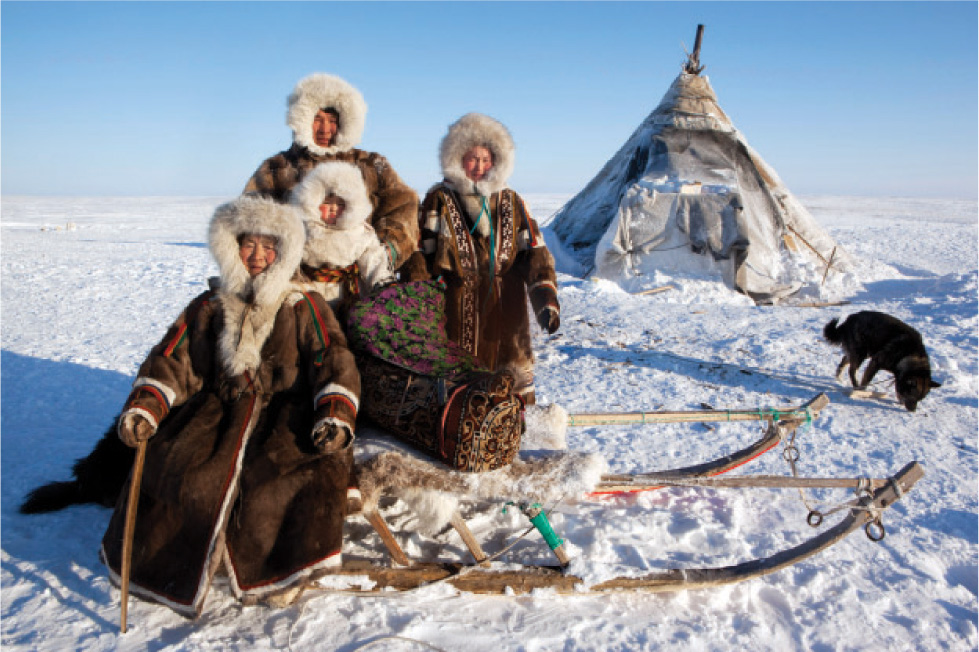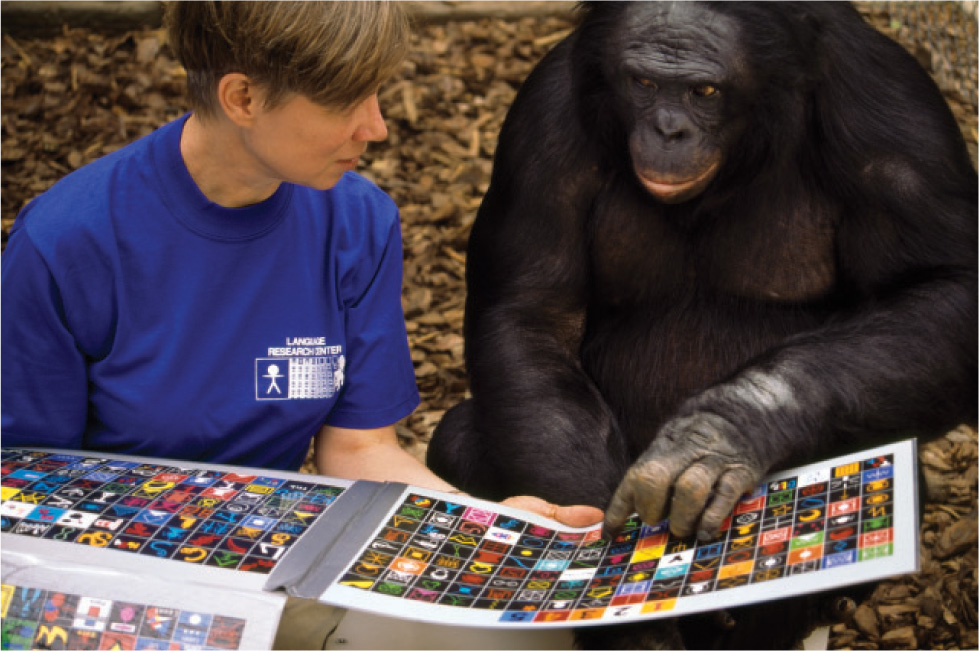24.5 CULTURE, LANGUAGE, AND CONSCIOUSNESS
Culture is generally defined as a body of learned behavior that is socially transmitted among individuals and passed down from one generation to the next. Culture has permitted us to transcend our biological limits. To take a simple example, clothing and ingeniously constructed shelters have enabled us to live in extraordinarily inhospitable parts of the planet, like the Arctic (Fig. 24.17). The capacity to innovate coupled to the ability to transmit culture is the key to the success of humans.

24.5.1 Culture changes rapidly.
Culture, of course, changes over time. In many ways, cultural change is responsible for our species’ extraordinary achievements. Genetic evolution is slow because it involves mutation followed by changes in allele frequencies that take place over many generations. Cultural change, on the other hand, can occur much more rapidly. Ten years ago, nobody had heard of smartphones, but today, millions of people own them. Or think of the speed at which a change in clothing style—a shift from flared to straight leg jeans, for example—spreads through a population. Today’s human population as a whole is genetically almost identical to the population when your grandparents were young. But think of the cultural changes that have occurred in the 50 years or so between your grandparents’ youth and your own.
Despite this clear contrast between biological evolution and cultural change, we should not necessarily think of the two processes as independent of each other. Sometimes cultural change drives biological evolution.
A good example of the interaction between cultural change and biological evolution is the evolution of lactose tolerance in populations for which domesticated animals became an important source of dairy product. Most humans are lactose intolerant. Lactose, a sugar, is a major component of mammalian milk, including human breast milk. We have an enzyme, lactase, that breaks down lactose in the gut, but, typically, the enzyme is produced only in the first years of life, when we are breast-feeding. Once a child is weaned, lactase production is turned off. Lactase, however, is clearly a useful enzyme to have if there is a major dairy component to your diet.
Archaeological and genetic analyses indicate that cattle were domesticated probably three separate times in the past 10,000 years: in the Middle East, in East Africa, and in the Indus Valley. In at least two of these cases, there has been subsequent human biological evolution in favor of lactose tolerance, that is, continued lactase production throughout life. Analysis of the gene region involved in switching lactase production on and off has revealed mutations in European lactose-tolerant people that are different from those in African lactose-tolerant people, implying independent, convergent evolution of this trait in the two populations. Furthermore, we see evidence that these changes have evolved very recently, implying that they arose as a response to the domestication of cattle. Here, we see the interaction between cultural change and biological evolution. Biological evolution of continued lactase production has resulted from the change in a cultural practice, namely cattle domestication.
24.5.2 Is culture uniquely human?
Even nonprimates are known to be capable of learning from another member of their own species—culture is not uniquely human. Bird songs, for instance, may vary regionally because juveniles learn the song from local adults. In a famous case, shown in Fig. 24.18a, small birds called blue tits (Parus caeruleus) in Britain learned from each other how to peck through the aluminum caps of milk bottles left on doorsteps by milkmen to reach the rich cream at the top of the milk. Presumably, one individual discovered accidentally how to peck through a milk bottle cap and the others then imitated it.

Nor is teaching, one way in which culture is transmitted, limited to humans. In teaching, one individual tailors the information available to another in order to facilitate learning. Teaching and imitation together make learning highly efficient. Adult meerkats teach young meerkats how to handle prey by giving them the opportunity to interact with live prey (Fig. 24.18b).
The most sophisticated example of nonhuman culture is shown by chimpanzees. Detailed studies of several geographically isolated populations have revealed 39 culturally transmitted behaviors, such as ways of using tools to catch insects, that are specific to a particular population (Fig. 24.18c). West African Chimpanzees in Guinea and the Ivory Coast both use tools to help them harvest the same species of army ants for food (and avoid the painful defensive bites of the ants), but each population has its own distinct way of doing this. Chimpanzees, then, are like us in having regional variation in culture.
Despite the cultural achievements of other species, it is clear that culture in Homo sapiens is very far removed from anything seen in the natural world. We are amazingly adept at imitation, learning, and acquiring culture. Teaching, learning, and cultural transmission all benefit from another extraordinary human attribute, language.
24.5.3 Is language uniquely human?
The short answer is again no, language is not unique to humans. The waggle dance of a worker bee on its return to the hive communicates information on the direction, distance, and nature of a food resource (Chapter 45). Vervet monkeys use warning vocalizations to specify the identity of a potential predator: They have one call for “leopard,” for example, and another for “snake.” However, most animal languages are limited. Even if a chimpanzee wished to communicate conversationally as we do, it would not be able to because its larynx is not capable of such subtle vocalizations.

Attempts have therefore been made to explore the linguistic capabilities of chimpanzees by teaching individual chimpanzees sign language or other forms of visual communication (Fig. 24.19). In a number of famous experiments, chimpanzees were able to acquire extensive vocabularies of signs and to construct elementary sentences. It is difficult, however, to evaluate the meaning of this research because the animals’ achievements are entirely the product of the training program. Perhaps the limitation is most clearly seen when we try to teach an animal to use metaphor. Time, for example, is often described using a spatial metaphor. An event in a time line on the left-hand side of a page is understood to come before an event on the right in time. Not even the best-trained chimpanzees can grasp this concept.
Grammar provides a set of rules that allow the combination of words into a virtually infinite array of meanings. Noam Chomsky, father of modern linguistics, has pointed out that all human languages are basically similar from a grammatical viewpoint. Humans have what he has called a “universal grammar” that would lead a visiting linguist from another planet to conclude that all Earth’s languages are dialects of the same basic language. That universal grammar is in some way hard wired into the human brain in such a way that every human infant spontaneously strives to acquire language. The specific attributes of the language depend on the baby’s environment—a baby in France will learn French, and one in Japan will learn Japanese—but the basic process is similar in every case. Chimpanzees, and the entire natural world, lack the drive toward the acquisition of a grammatical language.
24.5.4 Is consciousness uniquely human?
Descartes famously wrote, “Cogito, ergo sum”—“I think, therefore I am.” Can we legitimately rewrite his statement to declare, “Animals think, therefore they are”? With the growth of the animal rights movement, particularly in reference to the treatment of animals in factory farms, this question is of more than academic interest. We now have many examples of animal thinking from a range of species, including, not surprisingly, chimpanzees and gorillas.
Perhaps more remarkable are the examples that come from animal species that are not closely related to us. In experiments carried out by Alex Kacelnik in Oxford, England, a pair of New Caledonian Crows was presented with two pieces of wire, one straight and the other hooked, and offered a food reward that could be obtained only by using the hooked wire. One member of the pair, the male, disregarded the experiment and flew off with the hooked wire. The female, however, having discovered that she could not get the food reward with the straight wire, went to some considerable trouble to bend a hook into the straight wire. She succeeded in getting the food. It is difficult to deny that the crow thought about the problem and was able to solve it, perhaps in the same way as we would. Definitions of consciousness are contested, but, as with language and culture, it seems clear that other species are capable of some form of conscious thought.
The evolutionary biologist Theodosius Dobzhansky once said, “All species are unique, but humans are uniquest.” Our “uniquest” status is not derived from having attributes absent in other species, but from the extent to which those attributes are developed in us. Human language, culture, and consciousness are extraordinary products of our extraordinary brains. Nevertheless, as Darwin taught us and as we should never forget, we are fully a part of the natural world.